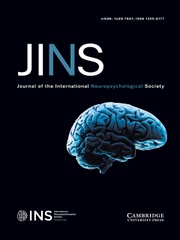Regular Research
Neuropsychological Profiles of Patients with Progressive Apraxia of Speech and Aphasia
-
- Published online by Cambridge University Press:
- 22 July 2021, pp. 441-451
-
- Article
- Export citation
Baseline Differences in Long-term Survivors and Nonsurvivors of the Colorado/Columbia Fetal Implant Trial
-
- Published online by Cambridge University Press:
- 14 June 2021, pp. 452-459
-
- Article
- Export citation
Two Immersive Virtual Reality Tasks for the Assessment of Spatial Orientation in Older Adults with and Without Cognitive Impairment: Concurrent Validity, Group Comparison, and Accuracy Results
-
- Published online by Cambridge University Press:
- 03 June 2021, pp. 460-472
-
- Article
- Export citation
Performance Validity and Outcome of Cognitive Behavior Therapy in Patients with Chronic Fatigue Syndrome
-
- Published online by Cambridge University Press:
- 16 June 2021, pp. 473-482
-
- Article
-
- You have access
- Open access
- HTML
- Export citation
Comparison of Neuropsychological Assessment by Videoconference and Face to Face
-
- Published online by Cambridge University Press:
- 24 May 2021, pp. 483-493
-
- Article
- Export citation
Exploring the Semantic Structure of WMS-IV Verbal Paired Associates using the Hub-and-Spoke Model
-
- Published online by Cambridge University Press:
- 24 May 2021, pp. 494-502
-
- Article
- Export citation
Validation of the Brief International Cognitive Assessment for Multiple Sclerosis (BICAMS) in the Russian Population
-
- Published online by Cambridge University Press:
- 16 June 2021, pp. 503-510
-
- Article
- Export citation
The 32-Item Multilingual Naming Test: Cultural and Linguistic Biases in Monolingual Chinese-Speaking Older Adults
-
- Published online by Cambridge University Press:
- 18 June 2021, pp. 511-519
-
- Article
- Export citation
Critical Review
Normative Data for Adult Mandarin-Speaking Populations: A Systematic Review of Performance-Based Neuropsychological Instruments
-
- Published online by Cambridge University Press:
- 10 August 2021, pp. 520-540
-
- Article
- Export citation
Front Cover (OFC, IFC) and matter
INS volume 28 issue 5 Cover and Front matter
-
- Published online by Cambridge University Press:
- 11 May 2022, pp. f1-f4
-
- Article
-
- You have access
- Export citation

